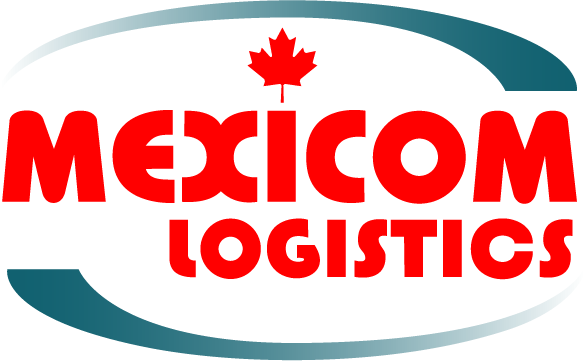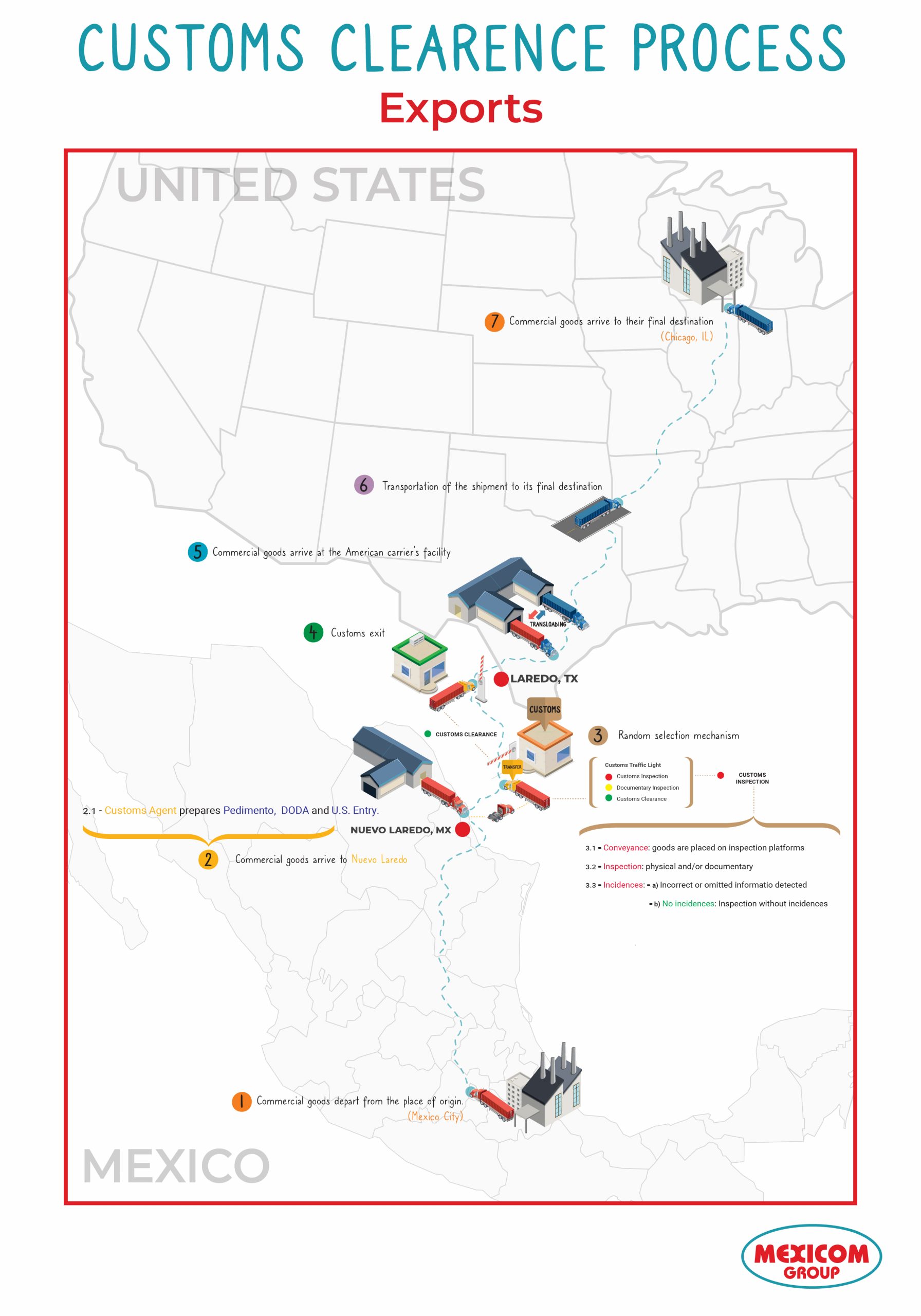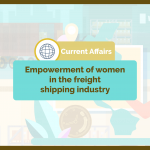[Infographic] Customs Clearance Process from Mexico to the United States
A detailed infographic that will explain all the most important steps to correctly go through the customs clearance process. This visual explanation is an essential tool for all individuals navigating the international trade procedures in North America, especially those in the United States and Mexico.
Mexicom Group offers customs brokerage services
Mexico – US freight shipping & customs clearance process
1. Commercial goods depart
The goods depart from the place of origin; in this case, from the state where the manufacturing facility is located in Mexico, and drive up to the border in Nuevo Laredo, MX – Laredo, TX to undergo border crossing and begin the customs process.
2. Commercial goods arrive at the carrier’s facility (Nuevo Laredo).
After the commercial goods are picked up at the manufacturing facility in Mexico, they are transported up to the United States border by ground transportation services, in this case to Nuevo Laredo, Mexico. The commercial goods are taken to the carrier’s yard to continue with the documentation inspection and ensure that all necessary information is available to cross the commercial goods smoothly.
At this stage, the Pedimento is prepared. Along with this document, it is also required to have the DODA and U.S. entry in order to continue with the customs process. Customs Agents from both countries (Mexico and the United States) are involved in handling this process properly.
IMPORTANT: Drayage carrier step
From this step onwards, a “drayage carrier” is used, which is responsible for moving the merchandise at the border before it is fully approved for crossing. Generally, these well-known drayage carrier only handle the movement of goods between customs and do not transport the cargo from the place of origin to the destination.
The drayage carrier has authorization to move within the area where most carriers do not have this permission at customs. The drayage carrier will be responsible for delivering the crossing documents that were previously prepared to cross the border.
*Note: There are carriers that have the benefit of moving cargo through Mexico, the United States, and customs without the need to use a drayage carrier, but this is not the majority of cases.
3. Clearing customs
In Mexico
The random selection is activated to verify that the commercial goods being transported do not have any irregularities. Many of these inspections are done randomly; if everything is in order, the inspection should not cause any issues in transportation.
The goods go through a well-known “customs traffic light” that, as its name suggests, consists of three different phases indicating whether the commercial goods needs to be stopped or can continue its course.
Customs Traffic Light
- Customs Inspection
- Document Inspection
- Customs Clearance
Customs Clearance: No irregularities are found in any of the documents and/or merchandise, and the process can continue without delaying the exportation. At the end of this phase, the aim is to reach this point regardless of whether a documentary or physical inspection is required previously.
Document Inspection: As the name suggests, a more extensive review of all the required documents is conducted to ensure no irregularities are found, and that all provided documents have been correctly filled out. Otherwise, the documents undergo further inspection, followed by correction, to obtain customs clearance and proceed with the exportation of goods.
Customs Inspection: The commercial goods must undergo a physical inspection to verify that the commercial goods being transported are appropriate and have the necessary permits to leave the country of origin and enter the United States.
If this phase is reached, three outcomes are possible: clearance, inspection, and incidents.
Clearance: Goods are placed on a review platform for physical inspection of commercial goods.
Inspection: This inspection ensures either physically checking the goods and/or ensuring that the documents are in order.
Incidents: Incorrect or omitted information is detected.
At the end of these steps, a “clearance without incidents” is concluded, and the customs process can continue.
In the United States
“The US commercial inspection process is made up of two main categories of Inspection: primary and secondary. The primary inspection involves a documentation review, a brief interview with the driver, and possibly a brief inspection of the vehicle. Inspections “Secondary inspections are conducted by a wide range of agencies, including Customs, the Department of Agriculture (USDA), the Department of Food and Drug Administration (FDA), the Environmental Protection Agency (EPA), and others.” (Oja & Villa, Texas Transportation Institute, 2022)
4. Customs Exit.
In this step, the drayage carrier heads to the exit module where they will be granted access to the United States and carry out the border crossing effectively.
5. Commercial goods arrive at the carrier’s facility of the American line.
Once the commercial goods are approved to enter the United States, they are taken to the yard of the American carrier line that will transport the goods to the final destination. Most of these yards are located on the American side of the journey, specifically in Laredo, TX. For exports (from Mexico to the United States), if there is any type of additional service such as transshipment, it will always occur at the carrier’s yard once it crosses into the United States.
6. Transportation of the shipment to its final destination.
The commercial goods are transported to their final destination.
7. Commercial goods arrive at the final destination.
After transporting the goods through Mexico and the United States, we can conclude the commercial goods transportation process when freight is delivered at the final destination.
Defining key words
Pedimento
The “pedimento” is a fundamental document for exporting goods and demonstrating to the authorities that taxes have been paid and the requirements of foreign trade have been fulfilled.
It is a document used by the Foreign Trade of the United Mexican States. Providing information such as the destination or origin country, the quantity of merchandise, and the agreed prices. Specifically for exports, the customs pedimento demonstrates the legal departure of the merchandise from the national territory (in this case Mexico), while for imports, it confirms the legal entry of foreign merchandise into the country (United States/Canada).
DODA
It is the Document of Operation for Customs Clearance (DODA), which is generated with the information from the validated and paid pedimentos or the consolidated notice, as applicable, and serves to activate the random selection mechanism, in order to carry out the customs clearance of the goods, integrating one or more pedimentos within a single document, replacing the “Document Relation”, pedimento printing, simplified pedimento form, consolidated notice printing, electronic import and export notice printing.
The DODA is created using the information from the pedimentos that have been validated and paid, or from the consolidated notice if applicable. This document includes the electronic signature of the customs agent and the digital seal of the SAT and is an integral part of the new Foreign Trade Tax Administration Model (MATCE). This model aims to simplify processes and reduce bureaucracy related to foreign trade.
U.S. Entry
Custom entry is an official declaration of information on imported freight. US Customs and Border Protection (CBP) requires custom entry forms on all international freight.
This is a document that the United States requires to import any type of commercial goods into the country.
Random Selection Mechanism
It is an authorized instrument activated during the process of merchandise clearance for customs recognition upon entering Mexico.



![[Infographic] Customs Clearance Process from Mexico to the United States [Infographic] Customs Clearance Process from Mexico to the United States](https://mexicomlogistics.com/wp-content/uploads/bfi_thumb/dummy-transparent-qmy27ecj1ko1plcszcxguosvh2jrc880u5swuo0z3s.png)







